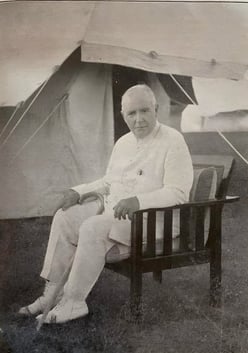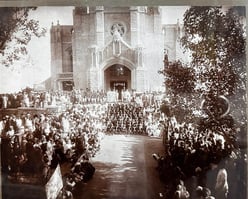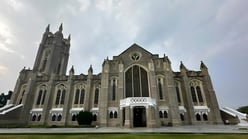From Tents to Temples: The Evolution of Missionary Work in Medak
The history of missionary work in Medak is a fascinating tale of resilience, dedication, and transformative change. In the early 19th century, when missionaries first set foot in this lush, jungle-covered region of northern Deccan, they faced daunting challenges. With little more than tents as their temporary homes, they embarked on a journey to spread Christianity and uplift the local communities.
DRS Chaitanya
10/26/20243 min read


From Tents to Temples: The Evolution of Missionary Work in Medak
The history of missionary work in Medak is a captivating narrative of resilience, dedication, and transformative change. In the early 19th century, when missionaries first ventured into this lush, jungle-covered region of northern Deccan, they encountered daunting challenges. Armed with little more than tents, they embarked on a mission to spread Christianity and uplift local communities.
The Early Days: Living in Tents
In 1813, the first missionaries arrived in Medak, setting up camp near the quaint village of Pasuputeru. In an area still untouched by modernity, these pioneers lived in tents, battling the elements while striving to establish a foothold for their faith. Their mission was both spiritual and humanitarian, addressing pressing needs such as food shortages and healthcare.
Rev. C.W. Posnett, a key figure in this narrative, arrived later and quickly connected with the communities through his proficiency in Telugu. He provided crucial support during droughts and famines, symbolizing the missionaries' initial vulnerability and their unwavering commitment to serve the people.
Establishing a Presence
As time passed, the need for permanence became clear. The tents that had once served as temporary shelters evolved into mission compounds, where schools, medical facilities, and places of worship began to flourish. This shift marked a transition from mere survival to establishing a long-term presence.
Recognizing education as essential for empowerment, Rev. Posnett and his team established schools that taught religious principles alongside literacy and vocational training. This dual focus laid the groundwork for a more integrated community approach.
The Birth of the Medak Cathedral
A pivotal milestone in this journey was the laying of the foundation for the Medak Cathedral in 1913. Designed to be a symbol of faith and resilience, Rev. Posnett sought plans from England, and construction began after careful consideration. Completed in 1924, the cathedral was more than just a place of worship; it represented the community's growth and commitment to Christianity.
Generous donations from local congregants and funds raised in England made this dream a reality, celebrating a collective effort that transformed tents into a majestic temple.
A Legacy of Service and Empowerment
The evolution of missionary work in Medak extended beyond building structures; it fostered a sense of community and addressed the needs of the people. Missionaries established dispensaries and hospitals, providing crucial healthcare to those in need. They also launched agricultural schools and cooperative farming initiatives to combat poverty and empower local farmers.
Rev. Posnett's holistic approach, intertwining faith with practical support, laid the foundation for a thriving Christian community in Medak. His work, along with that of other missionaries, uplifted many lives, creating a legacy that endures today.
Remembering Charles Walker Posnett: A Beacon of Faith
Charles Walker Posnett dedicated his life to leading others to God, profoundly impacting the Medak region. Known as "Posnett Dora," he baptized over 1,000 individuals, yet he was selective, ensuring that candidates had sufficient understanding of their faith and access to pastoral support. His commitment to the Gond people began in 1931, followed by a significant religious movement in 1932.
By 1936, he established elementary schools and initiated adult education in 1937, fostering spiritual and intellectual growth. The 1938 census revealed that 109,000 Christians had been baptized across the region, a testament to his fervent evangelism. Rev. Posnett prioritized the gospel, often skipping missionary meetings to focus on his ministry.
He took believers from villages like Papannapet, Kurtivada, and Sardhana to the rivers for baptism, demonstrating his dedication to their spiritual journey. In his final sermon on May 28, 1939, he delivered a heartfelt message, urging, “Build the churches on the foundations I have laid, accomplish the works I have begun.”
Posnett’s legacy lives on, as he showed God’s love through his actions and only baptized those who demonstrated genuine faith and commitment. His unwavering dedication continues to inspire countless lives in the Medak Diocese and beyond.
Conclusion: From Humble Beginnings to Lasting Impact
The story of missionary work in Medak is a remarkable journey of transformation. From their humble beginnings in tents, missionaries evolved into pillars of the community, building not just churches but schools, hospitals, and a sense of hope. Today, the Medak Cathedral stands as a magnificent symbol of faith, inspiring and serving the community.
As we reflect on this journey, it is essential to acknowledge the challenges faced and the resilience demonstrated by those who paved the way for future generations. The legacy of missionary work in Medak serves as a powerful reminder of the impact of faith, service, and community in creating meaningful change.





Explore
Discover the history and beauty of Medak Church.
for any suggestions/feedback
Connect
cathedralmedak@gmail.com
© 2024. All rights reserved. www.MedakChurch.com


